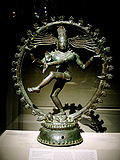Parsurameswara Temple
| Parsurameswara Temple | |
|---|---|
Kalinga Architecture | |
| Completed | 7th century CE |
Parsurameswara Temple (

Parashurameshvara Temple has a
History

Parashurameshvara Temple is one of the Parashurameshvara group of temples, considered to be the oldest temples in Bhubaneswar.[2][3][4] Some historians believe Parashurameshvara Temple to have been built in the early 8th century CE., subsequent to the construction of the Satruguneswar, Bharateswar and Lakshmaneswar temples in the late 7th century, although K.C.Panigrahi places the date as 650 CE.[2][5] Fergusson believed that the temple might have been initiated at around 500 CE.[6] A mid-7th century date is agreed by most scholars based on style and the presence of the eight planets which appear over the door to the inner sanctum as the later temples portray nine.[7]
Parashurameshvara Temple was built by the
Architecture

The Kalingan temples have two parts: the sanctum, called

The jagamohana is rectangular in shape and has a two-element sloping roof with clerestory windows between them.[13] The jagamohana measures 24.94 × 18.33 ft (7.6 × 5.6 m) from the inside and 29.33 × 28.58 ft (8.9 × 8.7 m) from the outside.[11] The latticed windows are classified as pata jali where perforations are square or rectangular in shape. In addition, there are trellised windows with slabs of stone sculptures depicting dancers and musicians.[14] Light enters the interior through doors and the latticed windows. The junction of the vimana and the jagmohana is not cleanly built, leading some scholars to postulate that the porch was added at a much later date; however, the primitive connection is attributed to the building technique. The temple was constructed by burying completed portions in inclined layers of earth up which heavy pieces of stone were dragged.[7]

The temple is one of the earliest examples of the

The temple contains the earliest representation of a six-armed
Though the temple is a Shaiva shrine, it contains the images of numerous Shakta deities as Parsvadevatas sculpted on its walls. The temple is the first among Bhubaneswar temples to contain
There are grotesque figures of
Religious significance
Parashurameshvara represents Shiva as the lord of Parashurama, one of the avatars of Vishnu. According to Hindu legend, the temple derives its name from the penance of Parashurama and the resultant grace of Shiva.[17] Parashuramashtami is the major festival celebrated in the temple on the 8th day of Ashadha (June–July) when the festival image of Lingaraja is taken to Parashurameshvara Temple and feasted.[25]
Parashurameshvara Temple, along with Rajarani Temple and Vaitala Deula, substantiates the existence of the Devadasi tradition during the 7th and 8th centuries CE. Devadasis were girls dedicated to worship and service of a deity or a temple for the rest of their lives and usually enjoyed a high societal status. They were usually transferred to the king's palace and subsequently performed for the general masses.[26][27] The temple is considered the best preserved specimen among the various oldest temples in the city.[28]

See also
- List of temples in Bhubaneswar
Notes
- ^ Gopal, Madan (1990). K.S. Gautam (ed.). India through the ages. Publication Division, Ministry of Information and Broadcasting, Government of India. p. 175.
- ^ a b c d e f Pradhan, Dr. Baman Charan (September 2009). "Saktism at Bhubaneswar Through Ages" (PDF). Orissa Review. Government of Orissa e-Magazine: 10–102. Archived from the original (PDF) on 9 March 2014. Retrieved 23 March 2013.
- ^ O'Malley 1908, p. 57
- ^ Sturgis, Russell (1901). A dictionary of architecture and building: biographical, historical, and descriptive, Volume 2. The Macmillan Company. pp. 473–474.
- ^ a b Ghosh 1950, p. 23
- ^ Fergusson 1876, p. 435
- ^ a b c d e f "Parsurameswar temple". Department of Tourism, Government of Orissa. Archived from the original on 6 May 2012. Retrieved 23 March 2013.
- ^ O'Malley 1908, p. 187
- ^ ISBN 0-87413-399-8.
- ^ "List of monuments in Orissa". Archaeological Survey of India. Retrieved 24 March 2013.
- ^ a b Ghosh 1950, p. 72
- ISBN 978-1-58394-207-9.
- ^ Ghosh 1950, pp. 21–22
- ^ Ghosh 1950, p. 32
- ISBN 978-81-207-2503-4.
- ISBN 978-81-224-1587-2.
- ^ ISBN 978-0-8239-3180-4.
- ^ Patel, C.B. (September 2008). "Mahisamardini Durga-Antiquity and Iconography" (PDF). Orissa Review. Government of Orissa e-Magazine: 3. Archived from the original (PDF) on 9 March 2014. Retrieved 23 March 2013.
- ^ O'Malley 1908, p. 242
- ISBN 1-57607-004-2.
- ^ a b Eastwick, Edward Backhouse; Murray (Firm), John (1882). Murray's hand-book: Bengal, N.W. Provinces & Burmah. Murray. p. 126.
- ISBN 978-81-7650-097-5.
- ISBN 978-1-61530-203-1.
- ^ Ghosh 1950, p. 24
- ^ O'Malley 1908, p. 240
- ISBN 978-81-7648-130-4.
- ISBN 978-81-8424-584-4.
- ^ {{cite book title=The legendary cities of India|first=Urmila|last=Verma|publisher=Publication Division, Ministry of Information & Broadcasting, Government of India|isbn=978-93-5409-100-1|year=2020|pages=18-19}}
References
- Ghosh, D.P.; Bose, Nirmal Kumar; Sharma, Y.D. (1997). Designs from Orissan Temples (PDF). Calcutta and London: Thacker's Press and Directories, Limited. ISBN 81-7387-075-6. Archived from the original(PDF) on 4 March 2016. Retrieved 23 March 2013.
- Fergusson, James (1876). History of Indian and Eastern architecture, Volume 3. London: Harvard University.
- O'Malley, Lewis Sydney Steward (1908) [1908]. Bengal District Gazetteer : Puri. Logos Press. p. 57. )

